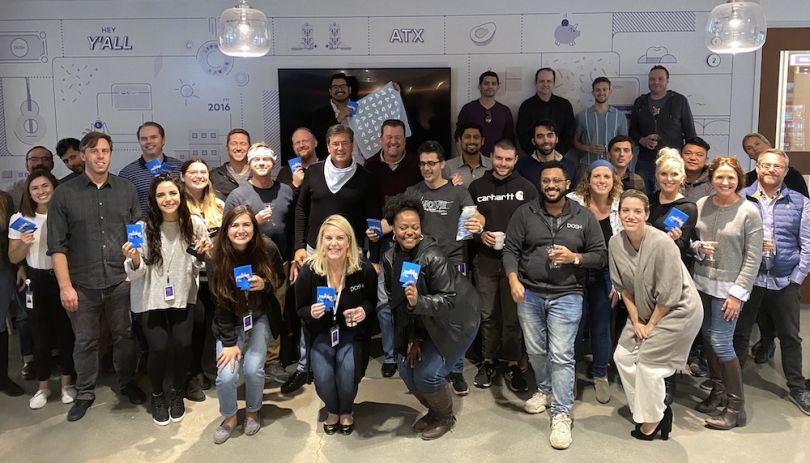Imagine business analysts, marketing teams and even the C-suite having the power to interpret data without the help of the entire IT department.
That’s just one goal of data democratization, the idea that every member of a business should have access to its data and be empowered to interpret it without gatekeepers. At the following Austin tech companies, the mission of achieving real data democratization is an ongoing challenge that involves the adoption of tools like Tableau and Redshift, as well as the unification of siloed teams. According to local tech leaders, once data is easily accessible and analyzed across an organization, new business opportunities are realized.
At innovation lab BlackLocus, for example, leadership is working to empower even the most non-technical team members through visualization and centralization.
“We’ve built web applications for non-technical users and relied on visualization tools for stakeholders and datasets for analysts.” Miles Drew, a senior manager of business intelligence, said.

At BlackLocus, an innovation lab within The Home Depot, the team supports both brick-and-mortar consumers and online Home Depot shoppers. With that in mind, Senior Manager of Business Intelligence Miles Drew said understanding the wide range of customers through data is key in addressing their different needs and expectations.
What initial steps did you take to break down data silos across your organization?
The Home Depot originally acquired BlackLocus for its data capabilities. The teams quickly realized that data itself does not drive action. You have to make the data useful to the organization.
To solve this problem, BlackLocus began building software solutions to turn data into actionable insights. We have since created internal-facing tools and applications across a number of functional areas at The Home Depot. Our broad stakeholder base crosses online and brick-and-mortar in both the U.S. and Canada so ensuring data availability across these groups is key.
Developing software solutions has solved a number of data issues for the organization, but also creates new challenges. How do you support the analytics and data science communities in addition to non-technical groups? Ease of data access in sane structures is critical. We continually integrate the data “exhaust” from our products into APIs or The Home Depot’s enterprise data warehouse, working closely with our partners to ensure that BlackLocus and THD data live together in a happy marriage. This ongoing integration allows us to optimize current solutions and build new features.
What are some of the tools BlackLocus uses to integrate your data and make it more user-friendly for non-technical employees?
We have a number of solutions to break down data barriers at BlackLocus. We utilize tools developed internally as well as third-party software. We’ve built web applications for non-technical users and relied on visualization tools for stakeholders and datasets for analysts.
BlackLocus developed mamba (BlackLocus + python3 = black snake = mamba), our ETL framework, to quickly transform and move data from one place to another. Teams here all work together closely to ensure that we’re supporting data needs across our user base. We always strive to answer data questions before they’re asked.
We always strive to answer data questions before they’re asked.’’
Tell us about a specific win one of your teams saw as a result of having better access to data.
In 2020, we want to increase the market share of our online solutions relative to The Home Depot’s total online business. To help the team realize this goal, we created a dashboard for our product team and THD stakeholders that stratified cohorts of managed versus unmanaged product types. The dashboard contains historical executive summaries. It also has the ability to delve into product-level details, which is no small feat considering the size of THD’s product catalog.
Being able to scale our analyses this way requires thoughtful database design and visualization tool trickery. Ultimately, these portfolio statistics and insights allow the organization to use a data-driven approach to target features and complete category deep dives that will impact our goals.

At tech real estate company Amherst, Data Engineering Manager Logan Boyd said employees were recently able to consolidate data from properties’ smart-door locks with rental data and company marketing tools. As a result, team members are able to text prospective residents with other options they might like and get immediate tour feedback.
What initial steps did you take to break down data silos across your organization?
Our initial approach to breaking down data silos was to build out our product management team. We wanted a deep understanding of what the business was doing and how. We paired product managers up with the different business units and sent them out on ride alongs with business stakeholders. This exercise not only deepened our understanding of their work, but also helped strengthen the relationships between technology and the business.
As a result of that work, we made process maps detailing exactly how each business operated. Those maps helped us identify what data was being consumed and how we could better organize it. In the end, we were able to eliminate redundant databases and stop the game of telephone we were playing with our data.
What are some of the tools Amherst uses to integrate your data and make it more user-friendly for non-technical employees?
A shortlist of tools that we use, arranged in order from most to least technical, includes Snowflake Data Warehouse, Tableau and Alation. Snowflake allows us to easily prepare and provide large datasets in easy-to-query views through a web browser as long as the user understands some basic SQL query language.
Tableau is our reporting layer. A less-technical user can glean insights into data through predefined datasets and dashboards by slicing, dicing and filtering.
Finally, we’re just starting to roll out our newest tool. Alation will be the go-to destination for users anxious to learn about all of the data products we are building. While some technical skill is needed, a user will be provided with examples, documentation and crowdsourced information to help them to uncover and discover data that they can immediately use to drive business decisions.
Our initial approach to breaking down data silos was to build out our product management team.’’
Tell us about a specific win one of your teams saw as a result of having better access to data.
Recently, we were able to consolidate data from the smart-door locks on our rental homes with our property data and our marketing tools. This ability allowed us to create a better touring experience for prospective residents. We could text with prospective tenants, get feedback on homes they toured and recommend other properties they might be interested in.

At Dosh, data engineering and business intelligence teams have been involved in consolidating all of the fintech company’s data. Director of Engineering Derek Pursel said his team decided to work with Tableau to further unpack the data because of its ease of use and massive market adoption.
What initial steps did you take to break down data silos across your organization?
Breaking down silos across Dosh meant bringing all our data sources into one place. We chose AWS Redshift to help us do that for a few reasons. First off, AWS already hosted all of our relational databases. Secondly, Redshift natively integrates our data lake, which is stored in AWS S3. Finally, Redshift is massively scalable.
What are some of the tools Dosh uses to integrate your data and make it more user-friendly for non-technical employees?
After AWS Redshift basically indexed all of our data sources, we added Tableau to our dashboarding and exploration toolkit so that our business intelligence and product teams could dive into our data. We chose Tableau’s cloud offering so there were no servers to manage.
For external reporting and exploration, we developed a reporting tool that lets our customers see how their Dosh advertising campaigns are doing in real time. This insight allows our customers to click, drag and filter their data with easy-to-use graphs to show lift in spend, average order value and results of our test and control group experiments.
The combination of Redshift and Tableau has allowed us to quickly drill down into any aspect of our data.’’
Tell us about a specific win one of your teams saw as a result of having better access to data.
The combination of Redshift and Tableau has allowed us to quickly drill down into any aspect of our data. For example, from start to finish, our Tableau dashboard for Venmo Rewards took less than a week to develop. As a result, our Powered By Dosh platform was able to provide Venmo insights across millions of users.

In order to share information across departments, Director of Internal Communications Audrey Camp said Cognite located dependencies across team OKRs, asked leadership hard questions and implemented a new coaching process to help ensure all team members were in alignment. Every Cogniter now has access to one source of truth, Camp said.
What initial steps did you take to break down data silos across your organization?
One of the toughest challenges for Cognite has not been sharing data but sharing knowledge and information, particularly between people in different domains who need to collaborate. We’ve taken a lot of steps there, including integrated and cross-functional team models.
Last summer, Cognite went through a major growth spurt. As we expanded, we understood teams needed to be aligned across the organization, especially for our teams in Japan, Houston and Austin. At the time, because we were growing (and moving) so quickly, not everyone was able to see our executive team strategy and planning in a consistent and clear manner. In addition, we were still building up our middle-management layer and figuring out who owned what goals and OKRs for various teams.
So, in August of 2019, we implemented the new process. We located dependencies across team OKRs, asked leadership tough questions and implemented a coaching process to help teams. Even though it was a big update, we got virtually everyone involved. We held executive management accountable for what their teams were responsible for and why, dependencies across the organization and executing on OKRs. Every Cogniter now has access to one source of truth. The process even turned initial skeptics into believers and advocates.
What are some of the tools Cognite uses to integrate your data and make it more user-friendly for non-technical employees?
For a company as technical as we are, we have kept the OKR process simple, open and transparent. We break down Google Sheets from the company-level to the team-level. We’ve extended the process from organizational teams and business units to regional teams, like our North American and Japanese departments.
Some teams have integrated the OKRs with Jira to follow and measure progress. Groups like sales have created transparent dashboards they can share with other departments. As a company, we use Miro for brainstorming and have one central corporate strategy document, accessible to every Cogniter and updated and shared during all-hands meetings. Additionally, every team has access to virtual workshops for creating and updating their OKRs.
We did not want this to be a top-down process.’’
Tell us about a specific win one of your teams saw as a result of having better access to data.
We did not want this to be a top-down process. When we got our ISO security certification, the security auditor asked all teams about the OKR process. That process was a key contributor in us receiving our ISO certification. It signaled an alignment across the organization, as well as between internal and external communications.
Cogniters understand their impact on the product. Each team is required to articulate the value they are adding to the company goals. Doing so gives teams and individuals a sense of what they’re doing and why. The process is always evolving. But by creating and implementing OKRs, we’ve helped give every team member clarity, purpose and direction.








